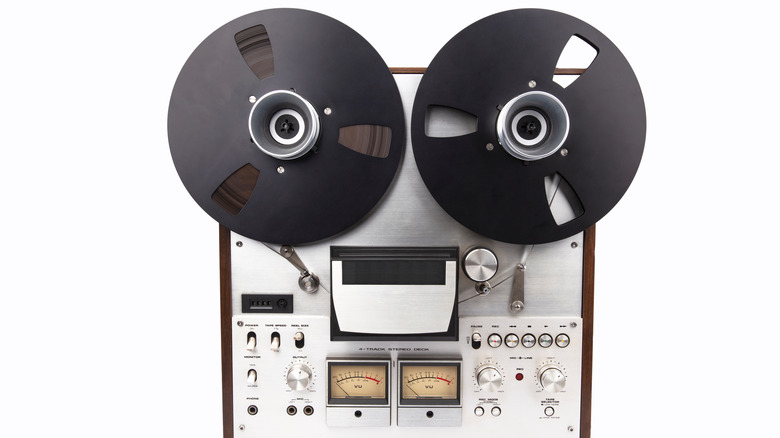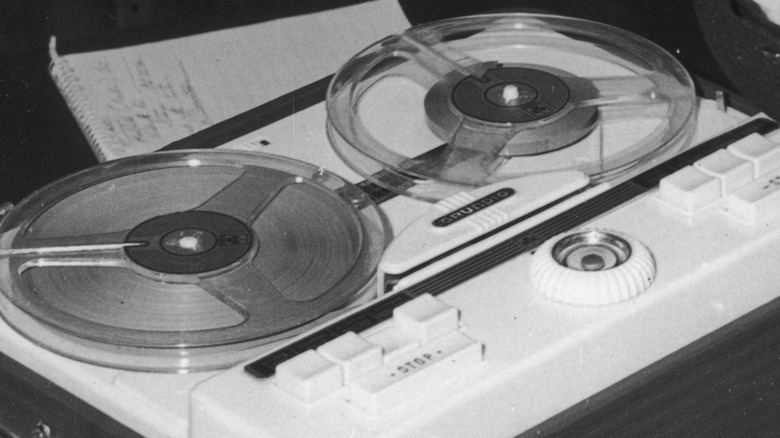The Forgotten History Of The Reel-To-Reel Tape
History is littered with revolutionary advances in technology that one day end up falling by the wayside — and nowhere is this more true than in the forgotten history of the reel-to-reel tape. Yes, that dusty old lug your parents — or maybe even your grandparents — have stored in their attic was once a model of modern science, just like your cell phone. For a moment, though, each piece of tech transforms how we live and, more often than not, whatever comes next is built directly on the shoulders of its predecessor.
These days it's likely you listen to your music and podcasts on a streaming service like Spotify. But after examining the forgotten history of the reel-to-reel tape you'll understand: We wouldn't be where we are today as far as personal and home entertainment without a little German invention from the 1920s that changed the way we hear (via Reel to Reel Tech). And these days, that old reel-to-reel in the basement may be more valuable than you think.
From paper tape to vacuum tubes 1920 to 1950
In the early days of reel-to-reel tape, sound wasn't captured on tape at all but instead, long paper strips. According to Reel to Reel Tech, early innovators in Germany bound ferric oxide to those paper strips, later replaced by much more durable plastic strips, that were then magnetized by a tape head. And with this, modern recording technology took an astounding evolutionary leap forward.
Further advancements weren't far behind. Vacuum tubes and mono, single-channel, sound were soon replaced by two-channel stereo sound. In the 1950s, legendary crooner Bing Crosby got in the game with the Ampex Corporation, and his early Ampex tube recorders are quite valuable today (via Museum of Magnetic Sound Recording). Additional advancements in reel-to-reel recording tech soon came about, including solid-state circuits, among others.
And with these steps forward, reel-to-reel quality also improved. The recording industry was forever changed. Ever listened to a little band called The Beatles? Their stuff was recorded on reel-to-reel tape, as was everything prior to about 1980. That was when reel-to-reel tape began to fall out of favor, especially among consumers.
Reel-to-reel tape to cassette decks 1980 to 2010
With the advent of smaller and more convenient cassette decks, the reel-to-reel tape began to fade in the 1980s, at least among home-audio enthusiasts. Some reel-to-reel tech continued to be used in the recording studio until the digital revolution took over, especially in the `90s and the early 2000s. But as early as the 1980s, most manufacturers discontinued consumer-grade reel-to-reel tech. And even though some claim analog recording methods like reel-to-reel simply sound better than digital recordings (via Scientific American), the ease and convenience of digital recording technology inspired sound recording engineers to also make the switch.
Around 2010, though, a renewed interest in vinyl record collecting sparked an interest among younger generations for vintage sound gear (via The Verge) and individuals began to research and collect classic reel-to-reel players and recording equipment. This pushed up prices on the gear, and sometimes on the tapes themselves. Some companies have even started to manufacture new reel-to-reel players, according to The Verge, and modern-day artists like Jack White from the White Stripes swear by analog sound quality (via CNET)
For these reasons and more, classic reel-to-reel players go for many thousands of dollars. So before dragging that cumbersome reel-to-reel player out to the curb for a yard sale, check with an expert! You just might have a treasure on your hands.


